
I just returned from an industry conference, “The Bold Use of Crayons in a Writer’s Brave New Digital World”, and found the pictured Gamo air rifle leaning against my desk. Placed on the schedule between a 450/400 3″ Nitro Express and a 450 Rigby, a small period of adjustment was appropriate. Finally, it dawned on me that I could do this. After all I owned an air rifle… even if it hadn’t been shot it for a few years.
Pass the gas please…
The air rifle market is predominately based on the same kind of creative marketing that drives firearm sales, see sub title above. Similar to the firearms industry, but there is at least one significant difference. Some air rifles are being represented well beyond credible applications and capability as manufacturers press on in the search for ever expanding demographics. No company selling firearms has ever suggested to potential customers, in ad copy or marketing hype, that they should go on Safari with a gun chambered for the 22 long rifle cartridge.
Publically represented, air rifle applications break with the spirit of sportsmanship in hunting and almost seem to motivate killing animals where pest prevention, table fare or even trophies are not in the equation. It’s as though companies are attempting to redefine the word “hunting” where, fortunately, real hunters don’t shoot game from cars and they don’t hunt hogs over a feed trough, inside of a blind, with an inadequately powered single shot pellet gun. One manufacturers site has a feature video where, literally, iguana hunting from an electric golf cart is featured. Ah, yes, a proud industry moment.
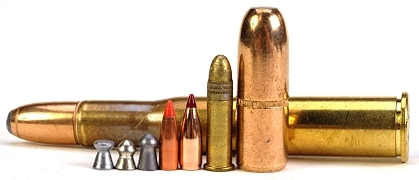
Above L-R: three variations of .177″ pellets, .172″ centerfire bullet, .204″ centerfire bullet, 22 LR, 500 grain .458″ bullet, and an assembled 450/400 Nitro Express cartridge.
Within the context of this piece, I deferred identification of an air rifle as anything but a tool for recreational target practice, specialized competitive shooting and/or a dispatcher of garden pests and edible small game to the camo wearing crowd that hunts from golf carts and SUVs, and the thirteen year olds who learn from these poor examples.
Now about that air rifle…
SOCOM, Special Operations Command, is an interesting group. Socom Extreme must be extraordinary or…. it’s a cheap misuse of the acronym in an attempt to attract people who wouldn’t know the difference. In this particular application, Extreme means the use of a heavier gas pressure generating spring to boost pellet velocity.
The Gamo Socom Extreme is of a simple break barrel, spring – piston design, its power generation is integral. The Socom does not require multiple manual pumps, it does not require a separate specialized high pressure pump or storage tank and it does not require a supply of CO2. Following the theme of a ready to shoot gun, the Socom Extreme is supplied with a 3-9×50 selectable color illuminated reticle scope with sturdy pinned mounts, an introductory supply of ammo and all required documentation.
|
||||||||||||||||||||||||||||||||||||
The Gamo company is based in Spain. The Socom Extreme is one of six Socom models offered by Gamo with at least the subject rifle manufactured in the UK. The models vary in stock configuration, barrel length, sighting equipment and caliber. The Extreme model was selected because of its advertised muzzle velocity, full length barrel and suggested range of applications.
The stock is injection molded and made of compound poly. It is not a composite stock as reported in numerous other publication. The stock does have artfully designed contours, an ambidextrous cheek piece and angular geometry which all combines to stiffen the stock and give it a substantial feel.
The Socom Extreme is heavy. At slightly over ten pounds, it outweighs most of the varmint center fire rifles we build in the shop and it is nearly four pounds heavier than our compact, light weight woods or mountain rifles and it is three pounds heavier than my favorite Mauser action, 375 Ruger full stock. Weight in a firearm is something that normally leads to some measureable performance gain. Heavy barrels and stocks may dramatically shrink group size or absorb recoil but, in the case of the Socom Extreme, the advantage isn’t clear.
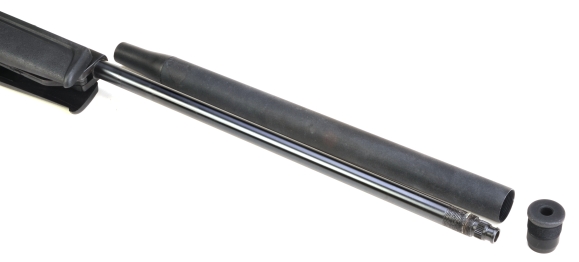
The weight is not in the barrel, the barrel is a straight 0.585″ outside diameter. The outside plastic shroud is 0.980″ in outside diameter, secured to the barrel with an aluminum plug that forms the gun’s muzzle… sort of. Considering the pellet size and form, as well as driving pressure, the barrel diameter is substantial. The plastic shroud is a good barrel protective device and it does provide a handhold while cocking the gun. It may even serve to stiffen the barrel and dampen vibration in an effort to minimize group size, but I didn’t want to risk damaging the gun by cocking and shooting it with the shroud removed to generate a comparison.

The barrel’s length is listed as 18″, however, the actual bore liner is recessed into a barrel shroud 0.550″, so net length is 17.450″. The shroud’s back bore is approximately 0.316″ in diameter. Barrel length does matter for air rifles, even if not in the same way it does with firearms. In the case of an air rifle, a longer barrel means that the pellet is under the influence of gas pressure elevated above ambient for a longer period of time. However, the gas pressure is not slow developing as is the case with firearms when smokeless powder is the propellant and longer barrels allow more complete burn and developing pressure persistence.
The Socom’s barrel is hinged, and compound levered, approximately four inches forward of the breech. The pressure generating spring is preloaded and the gun’s action is cocked by rotating the barrel downward in a 140° arc against 58 pounds of resistance. The gun is loaded by inserting a pellet, hollow base aft, when the barrel is in the tipped down position.
The Socom Extreme’s barrel chamber is emptied by pulling the trigger while pointing at a safe backstop. Spring – piston guns rely on the presence of a pellet in the barrel to seal the gun’s bore and dampen the movement of the piston. If no pellet is in place, the piston will meet little resistance, slam against the breech face and eventually cause damage to the gun. For that reason, don’t dry fire spring – piston air rifles.

The Extreme version Socom was not selected because of its optimal aesthetics. I believe the Socom carbine holds greater traditional firearm appeal, but the Extreme holds the high end of advertised velocity at 1,650 fps. I like the like stock geometry a lot. The comb height is right for a scope, the pull length is comfortable, the pistol grip is the right form and size and the forearm is hand filling and positioned for good off hand shooting balance.
Fancy glass
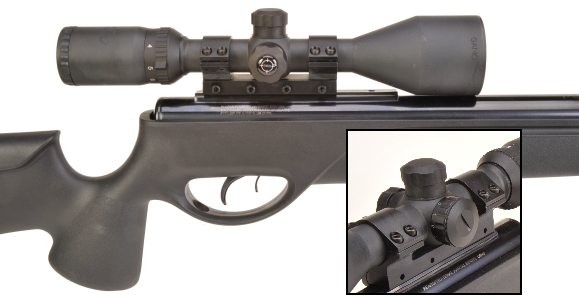
The Socom Extreme barrel is drilled and tapped for metallic sights, however, none are included with the rifle. Instead, the Extreme is supplied with a heavy duty 3/8″ rail mount one piece ring set and a 3-9x50mm scope. The mount rail is integral to the gun’s receiver. The scope has Gamo logos and is manufactured in China. From use and observation, this is a decent optical sight, made to withstand the vibrations and bi-directional recoil of a high performance spring – piston air rifle.
Spec wise, it is a 1/4″ click adjustment scope with 3″ of eye relief, 34′ – 12′ field of view, and 40″ of adjustment in both directions. The reticle is etched and illuminated as a three intensity red, green, blue dot or off. The control is on the left side of the scope as shown in the insert above. The image is bright, eye piece adjustment worked well and elevation and windage adjustments uniformly tracked. No, it isn’t a $500+ rifle scope, but it is a pretty good scope and absolutely workable for recreational target shooting, small game hunting and plinking.
Some of the other bits and pieces…
Comparatively speaking, the Socom’s trigger pull is long and springy. Sort of like shooting a striker pistol with a three inch pull. Your finger goes on a long and winding journey, feeling variable resistance and mechanical advantage ratios, until the gun finally discharges. Good news, the Socom is supplied with an second stage adjustable trigger, adjustment access through the hole in the trigger guard, that can improve pull, but it doesn’t control over travel and no setting approximates the feel of a centerfire rifle trigger. To me, this is one of those realities of air rifles that separate them from the crisp, clean feel of a firearm with a good trigger. But then, the triggers are performing different mechanical tasks.
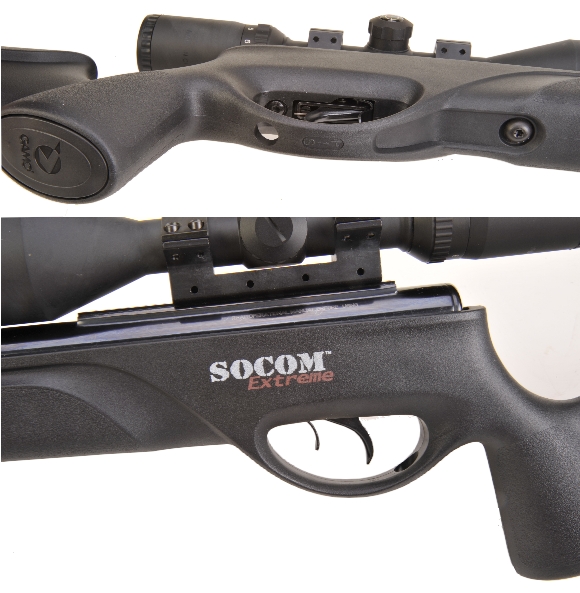
The safety placement and function, to someone who has been around ergonomic mechanical design, is a puzzler to the point it almost seems arrogant by placement. Could you imagine the designer explaining to the head of engineering the operation? “So I put the safety in front of the cocked trigger so it would be convenient. You just pull the short lever toward the long trigger, then stick your finger in the little space between the cocked trigger and the set safety and push forward to release. Oh, make sure you look at the safety when you set it so you don’t miss and bump the trigger. And make sure you don’t bump the trigger when you release the safety. Have you ever played Operation ?”.
We have entered the era of logo mania, not just on air rifles, but on conventional firearms in general. Badging emblazoned on floor places, sprawling messages on gun barrels, soft molded into recoil pads. The Socom Extreme’s receiver inscription is OK, although roll engraving would be nicer and a bit more sophisticated. The stock lettering? Not so much. If an air rifle is going to be marketed to serious shooters, hunters, especially at this price point, a little understated aesthetics for the sake of the new owner would be appreciated.
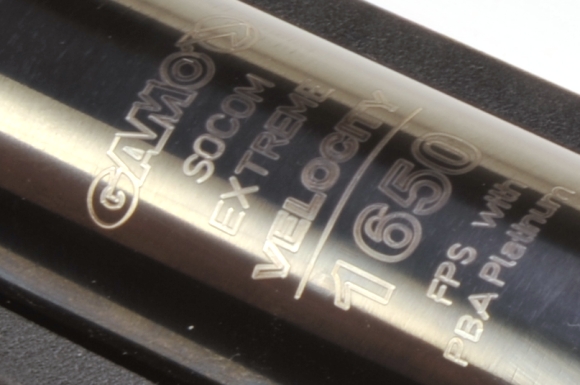
Now, about that 1,650 fps…
A carry over from firearms, data is rarely absolute so validating with a chronograph lends a lot of reality to the situation. I conduct such tests with all firearms and ammunition that pass through the shop. I gathered up three types of ammo, below left to right, back row unfired, front row recovered: Dynamit Nobel 9.4 grain Supermag, Gamo PBA Platinum 4.7 grain, Gamo TS-10 10.5 grain.
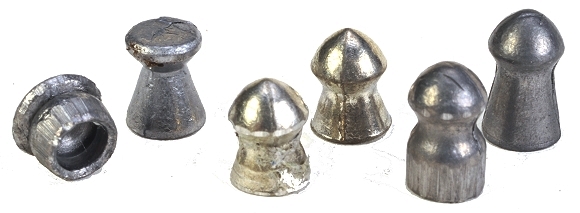
Average chronographed velocity was, respectively: 1084 fps, 1426 fps and 1030 fps. Short of spec, but exceptional none the less. The PBA Platinum exceeded the speed of sound which resulted in a report similar to a 22 caliber rifle. The other two pellet types were less noisy, but certainly not quiet.

Water soaked phone books were used to collect relative penetration numbers. As air rifles go, all of the ammo was impressive. In order listed above: 2.5″, 5″ and 4″.
Other than the soft lead Supermag ammunition, there was virtually no impact expansion of ammo. Pellet skirts did expand from gas pressure exerted within the gun’s bore. Not a big deal for this weight and velocity of projectile. Expansion would only result is greatly diminished penetration and there is not enough mass to open much of a wound channel.
The PBA pellets, made of low density tin alloy, offer initial high velocity and good penetration, however, the low mass projectile does not retain velocity or energy over the longer haul.
Power in perspective
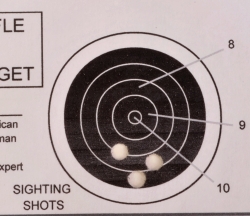 I was impressed by the Gamo Socom Extreme’s accuracy. The velocity, not so much, as these are really light projectiles, especially the non-lead alloy. This 25 yard group is representative of the gun’s shot to shot consistency, regardless ammo. In this case, the wad cutter Supermag ammo put up half inch groups.
I was impressed by the Gamo Socom Extreme’s accuracy. The velocity, not so much, as these are really light projectiles, especially the non-lead alloy. This 25 yard group is representative of the gun’s shot to shot consistency, regardless ammo. In this case, the wad cutter Supermag ammo put up half inch groups.
Outside of competitive shooting, this level of consistency is excellent for paper punching and small game hunting. Twenty five yards, seventy five feet. may not seem like much, but a typical .177″ air rifle will be done at thirty to forty yards as a practical matter. I do not know what the effects are of breaking and closing the barrel over an extended number of cycles
The long and short of it all
When I was done collecting air rifle data, I took a shot at the same wet phone books with a tiny North American Arms revolver and 26 grain Tin Winchester 22 LR ammo; eight inches of penetration and a lot larger “wound channel”. No, I am not suggesting using a 22 mini revolver for varmint or small game hunting, I am only trying to illustrate that an air rifle can be outdone by a very low power firearm and you would never catch me hunting wild hogs with a 22 LR.
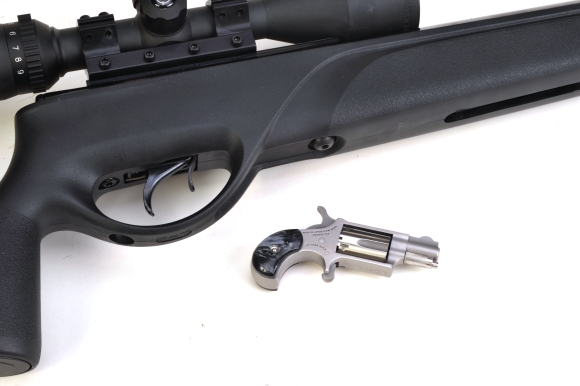
For recreational target shooting and small game hunting out to 30 or 40 yards, especially when in something other than rural surroundings, the Gamo Socom Extreme would be a fun gun and very effective for the task. They are well made, accurate and consistently reliable. Outside of those compromising conditions, these types of air rifles can’t approach the performance of even a 22 LR rimfire and a spring – piston break barrel actuation can get very old very quickly.
Am I being overly critical?
If this was a $100 air rifle and it was being positioned as a trainer, a plinker or even a small game hunter I would have had a totally different perspective to offer. I’d set aside the single shot capacity and power limitations for the sake of low cost and suggest that it might serve as a transitional rifle for a youngster or where civilization is setting in and target practice needs to be kept quiet. But this gun is being hyped for field use, including wild hog hunting and carries a $500 price tag.
There are plenty of sub $100 air rifles out there to purchase, and maybe convenience and low report make the twelve cents per shot cost of pellets, three times that of a 22 long rifle round, palatable. Then what does the $400 additional cost of the Socom Extreme do for its owner and what performance does it bring to the field? None. Not power, not accuracy, not silence, not durability. A quality target/varmint grade 22 rifle can be purchased for half the Socom’s price and a good centerfire deer rifle can be purchased for well under $400.
The Socom Extreme to me, represents an unfortunately blend of video game toys and lethality. It is a poor imitation of a real firearm being hyped for irresponsible purposes. If you like gadgets, knock yourself out, but don’t delude yourself into thinking you will be anything more than an adult running around the woods with a toy gun.

Email Notification